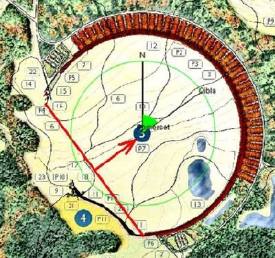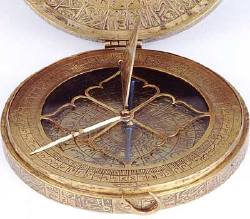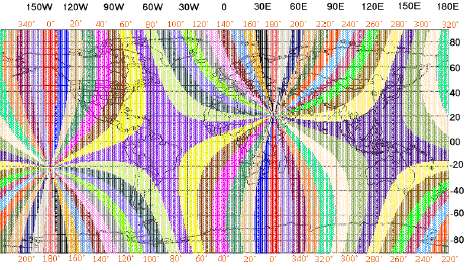Mast Qalandar (a.k.a. Aziz Akhmad)
 Normally, I receive four or five e-mail messages daily that I want to read, mainly from family and friends. That day I received two dozen, or more — from places as far as Swat in Pakistan to San Francisco in the US. It was not junk mail, but helpful advice, offered in earnest, on how to determine the exact direction of the qibla (the location of Ka’ba, the cubic structure in Mecca, towards which Muslims pray) in North America. The messages came in response to an article that I had written about the APPNA meeting, “I fell among (the APPNA) doctors”, which was published on ATP and in The News.
Normally, I receive four or five e-mail messages daily that I want to read, mainly from family and friends. That day I received two dozen, or more — from places as far as Swat in Pakistan to San Francisco in the US. It was not junk mail, but helpful advice, offered in earnest, on how to determine the exact direction of the qibla (the location of Ka’ba, the cubic structure in Mecca, towards which Muslims pray) in North America. The messages came in response to an article that I had written about the APPNA meeting, “I fell among (the APPNA) doctors”, which was published on ATP and in The News.
In that article, I had described the various events I witnessed, from the sidelines, at the annual get-together of the Pakistani-American doctors in Washington DC. The events included recreational, social, political, and spiritual activities, both organized and spontaneous. Among other things, I had mentioned, passingly, an incident where a doctor, seemingly in a rush to say his maghrib prayer, had asked me the direction of the qibla, and I had, reflexively, pointed to the west, whereas the qibla, here in North America, is generally to the east.
Reading the messages, what surprised me was the lengths to which the different writers went and the pains they took to explain the various ‘scientific’ techniques and procedures they thought should be employed to determine the exact direction of the qibla.
Personally, I never had a problem in determining the direction of the qibla. For me, in Pakistan, the qibla was always to the west. Actually, where I grew up, the direction of the qibla was toward the mountain behind which the sun set. A few degrees this way or that way didn’t matter as long as one faced the general direction of the mountain. No one ever heard of a debate or discussion on the subject. Nor anyone felt the need for employing any scientific techniques to determine the precise direction.
When I first came to the US, many years ago, as a young student, our campus was situated at the foot of a mountain range. And, just like back home, here, too, the sun set behind the mountains. Reflexively, I thought that must be the direction of the qibla. But, since we were on the other side of the globe, it didn’t take any deep understanding of Astronomy or Calculus to know that the direction of the qibla, here, was in the opposite direction – away from the mountains. One got used to the new orientation just as one got used to driving on the right-hand side of the road. Again, never did one hear of any deliberations or debate on determining the precise direction of the qibla – to the nearest decimal, that is.
But I guess those were the proverbial good old days when things were relatively simple. We used common sense to find answers to common questions. We hadn’t yet entered the field of “rocket science”. We stumbled on that branch of knowledge much later. (Incidentally, in those days in the US, we also didn’t read the label on a box of cereals to check if it contained animal proteins. Nor did we stop brushing our teeth for fear that the toothbrush might have animal bristles on it. We knew bristles on toothbrushes were made of synthetic fiber, thanks to DuPont who started making nylon in 1938.)
Some of the ” helpful advice” I received in my in-box varied from simple to very complex.
One writer offered a simple and easy-to-follow advice. He said:
“qibla direction in North America is North-East, not just East.”.
Another writer, a bit more precise, said:
“Qibla is 45 degrees North of East. ” Yet another said: “17 degrees North-East”
But the question is, which way exactly is the east? And how do you measure degrees? Carry a compass?
Another writer, Mr. Khan, from France, wrote:
“The physical direction of qiblah Q from the place where you live Y is a vector YQ. You can very well decompose this vector into YX (vector from your place Y to any landmark X) and vector XQ. The sum of these last two vectors, YQ+XQ will be the first one YQ.”
Since I didn’t quite follow the thread of Mr. Khan’s logic, I wrote back to him, thanking him for his advice and confessing that I had dropped mathematics as a subject at the first available opportunity in college, and therefore if he could explain his point in simple language.
Mr. Khan came back with a diagram of the globe, marked with points and lines, and a page length of explanation. I reproduce only a few lines of the explanation (you will know why):
“Any point in a rectilinear coordinates can be represented in (X, Y, Z) three dimensions. Since our earth is sphere, we better use the spherical coordinates. In this system we use R, Theta, and Phi, where R is the radius of the sphere, in this case radius of the earth, which remains constant, so we simply have to know Theta and Phi of any place to know its exact position …”
Mr. Khan reminds me of one of our professors who scribbled equations on the blackboard, furiously, like a man possessed, without looking back at the class, using up the chalk to the point where his fingers could not hold it any longer. While he would use up chalk after chalk on the blackboard, the class would pray for the bell to ring.
I decided not to seek any further explanation from Professor Khan.
 There were several other suggestions, some referring to the latitudes, longitudes and to the angle of the tilt of the globe etc. However, the most useful tip, because it was the quickest and did not involve any calculations on my part, came from someone in the US, from the West Coast (I suspect from Silicon Valley). The gentleman sent me an Internet link. All I had to do was open the given web page, enter my zip code, click Enter, and I would get the precise direction in the form of a red line pointing to the qibla.
There were several other suggestions, some referring to the latitudes, longitudes and to the angle of the tilt of the globe etc. However, the most useful tip, because it was the quickest and did not involve any calculations on my part, came from someone in the US, from the West Coast (I suspect from Silicon Valley). The gentleman sent me an Internet link. All I had to do was open the given web page, enter my zip code, click Enter, and I would get the precise direction in the form of a red line pointing to the qibla.
I opened the web page recommended by the writer, entered my New York zip code and clicked the Enter key. Up came, on the computer screen, a virtual 3-dimensional Google map of Manhattan, showing all the streets and landmark buildings. Penetrating through the maze of streets was a thick, solid, red line emitting, like a laser beam, from my specific address, on the West Side of Manhattan, heading straight into the Empire State Building!
Rather than choosing any of the solutions offered, that is, carrying a compass, trying to solve Professor Khan’s mathematical equations, or facing the Empire State Building, personally, I feel more comfortable with the 1400 years old advice that says: “Righteousness is not whether you turn your face to the east or the west” rather it is serving humanity and doing good deeds (2:177).
The article was also published in The News of August 15, 2008.




















































I am surprised at the extent of sarcasm in the comments wrt Qibla direction. Knowingly that I will get a lot of flak I must say that the ones who are showing sarcasm are the ones who probably do not care to offer prayers! I hope I am wrong.
Whereas one may offer prayer in any direction when the direction is not known, it is for Allah to accept his/her effort. But, when the means are there to determine the direction it should be used.
While we remain sarcastic of ourselves (i.e. Muslims), we must know that mathematics and geometry owe a lot to Muslims for its development. I am only apalled that others acknowledge it and we do not. IT MUST BE KNOWN THAT MUSLIMS IN FACT DEVELOPED SPHERICAL GEOMETRY IN THEIR QUEST TO FIND THE DIRECTION OF QIBLA ONCE THEY HAD SPREAD TO LANDS FAR OFF FROM MAKKAH. In that age it was the proverbial ‘rocket science’ for others.
I you care enough about something, you do get into details, and do try make it as close to perfect as possible. It depends on your ‘care’ level, or Ishq, some may call it faith too.
Lets try another similar problem: zabihah and non zabihah meat. Some of us would rather starve than eat non zabihah. Some among these starving people, do it without a logic. While some will research on the topic to the last opinion of a scholar before making a decision. On the other hand there will be people who make a decision otherwise.
If one zabihah eating person asks a non zabihah eater if a particular food is zabihah or not. The non zabihah eater does not know but since in his belief system everything is ok. says this is halal, and says so unconsciously. That is in a way borders unethical if not irresponsible.
However if he defends his action by justifying the superiority of his point of view over the other, that is blatantly wrong.
Just a little correction. I was the one who sent the internet link. By the way, I live on the East Coast (Washington DC), and I am not a young Silicon Valley internet person. I am a good old civil engineer from UET.
Majnoo, totally agree with you. We are all lost in detail. I know people here in Australia who carry a compass everywhere with them. Once I told someone when asked about the direction of Qibla that “I THINK” its that way, pointing North West. That was a mistake, should not have said “I think”. I got a lecture on importance of Qibla’s direction. I have learned my lesson, now I just point to North West with confidence and don’t start my sentence with “I think” any more.
Bhai Musalmaan, let Allah do his job of counting which of Opee sahib’s prayers are correct. Better you don’t interfere with His jurisdiction.